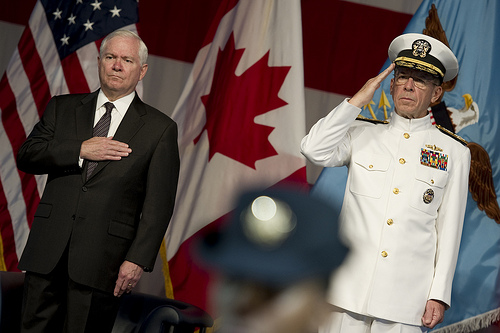Thought the debate about Canada joining the U.S. Star Wars missile defence shield was over? Maybe not. The latest round of Canada-U.S. border security talks could result in Canada joining “Star Wars,” and a lot more.
“We intend to pursue a perimeter approach to security,” said the joint statement by Prime Minister Stephen Harper and President Barack Obama in Washington this month.
The statement was light on details, but Canadians should be concerned that political and military leaders involved in border security talks are also discussing a massive expansion of North American Aerospace Defence Command (NORAD) — the joint U.S.-Canada military aerospace command for North America.
The security perimeter talks, purportedly aimed at easing border trade, might leave Canada sacrificing its ability to have an independent security policy and trapped inside a U.S.-dominated “Fortress North America.”
It is the latest in a debate over the Canada-U.S. military relationship that has spanned three generations.
Decades ago in the late 1950s, early in the Cold War, NORAD was set up to prevent a Soviet bomber attack on the United States from coming in over Canada. It was headed by a U.S. general, with a Canadian general as second-in-command. NORAD conducted surveillance of the airspace around North America for bombers, and exercised control by dispatching U.S. or Canadian fighter aircraft to intercept and shoot down any enemy planes.
But like most grand military projects, NORAD was nearly irrelevant just as it was being completed. By the 1960s intercontinental nuclear-tipped missiles largely replaced bombers. NORAD was given a new job: watching the world for missile launches, and warning America’s nuclear strike forces to prepare for an attack. It continued to play this role for decades, even long after the Soviet Union collapsed in1991.
By 2001, NORAD was again unprepared for the changing security environment. Preoccupied with watching outward for a Russian threat that no longer existed, NORAD was ill equipped to respond to hijacked commercial aircraft headed for New York and Washington on September 11.
Reacting to the attacks, President Bush created a new U.S.-only military command for North America, called Northern Command, and put it in charge of U.S. military activities in North America, including operational control of his expensive and malfunctioning continental missile defence system. Canada created its own Canadian-only domestic military command, called Canada Command, to coordinate with Northern Command in joint disaster and terrorist attack response, and other operations.
The U.S. general in charge of Northern Command was also given command of NORAD, with the Canadian general remaining as his second-in-command of NORAD. Together, they have wisely re-focused NORAD on assisting civilian agencies monitor commercial traffic over North America to prevent another 9/11 type of attack on cities and events such as the Vancouver Olympics.
But with the U.S paying more attention to the new kid on the block, “Northcom,” as it is called in military circles, Canadian military leaders have fretted over the potential for NORAD’s diminished importance to the Americans.
That’s why the Canadian military establishment pushed hard for Canada to join the U.S. missile defence system. But they sparked a public debate that raged for two years over the viability, need and security implications of the unproven missile system. Would it lead to a new arms race — and the weaponization of space?
Prime Minister Paul Martin famously decided not to join in 2005. His decision received wide public support, but enraged the military leadership and the defence lobby (their dire warnings of NORAD’s demise have proved to be overblown).
The following year, the military shot back with a report by the Canada-U.S. Bi-National Planning Group recommending a single North American security plan enforced by an integrated continental military command, creating “enhanced coordination and cooperation among our foreign policy, defence and security organizations. The goal should be to achieve the level (although not necessarily the form) of cooperation that now exists in NORAD in all other domains.”
But the missile defence “No” decision set the tone of the political debate. In the end, NORAD was expanded just enough to add joint maritime surveillance to its mission, but nothing more.
Their plans have largely gathered dust for the last five years, until now.
A public relations campaign has already begun for deeper military integration. The same people who are lobbying Canada to purchase a fleet of F-35 stealth fighters, arguing the $16-21 billion expense will enhance Canada-U.S. military interoperability, are also backing an expansion of NORAD.
Retired lieutenant-general George Macdonald, former Canadian head of NORAD and an early advocate of joining “Star Wars,” appeared in newspapers recently calling for expanding NORAD to include land and sea defence. Incidentally, he is also a lobbyist for Lockheed Martin, the U.S.-based manufacturer of the F-35 stealth fighter.
Canadians weren’t convinced that Canada should join missile defence, and they were right. They are just as sceptical about the F-35 stealth fighters. The government needs to come clean with what it is planning for NORAD.
Steven Staples is the President of the Ridea Institute, an independent research, advocacy and consulting group in Ottawa. He is also author of Missile Defence: Round One.



